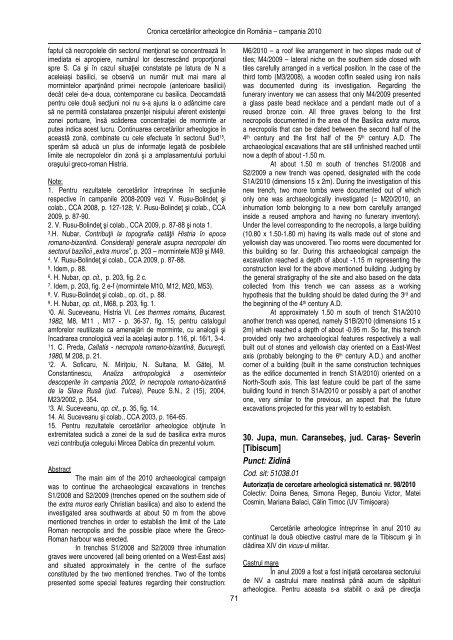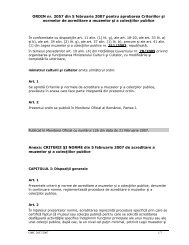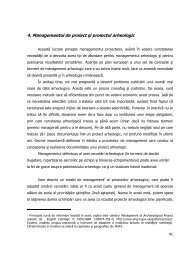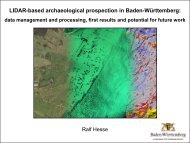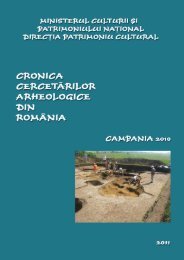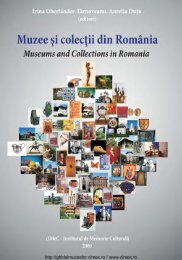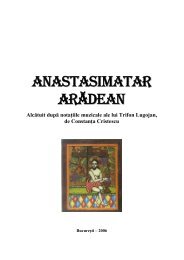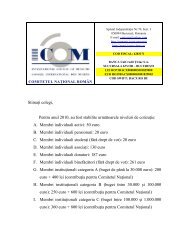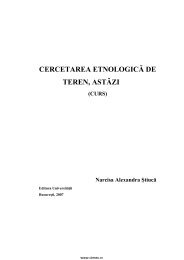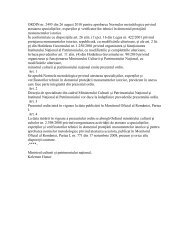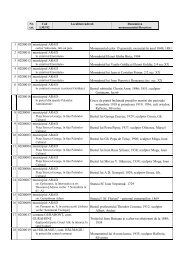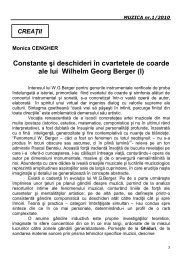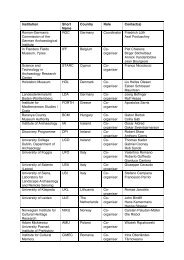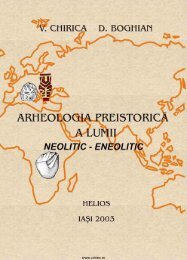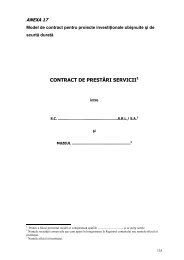Cronica-cercetarilor-arheologice-campania-2010 - cIMeC
Cronica-cercetarilor-arheologice-campania-2010 - cIMeC
Cronica-cercetarilor-arheologice-campania-2010 - cIMeC
Create successful ePaper yourself
Turn your PDF publications into a flip-book with our unique Google optimized e-Paper software.
faptul că necropolele din sectorul menţionat se concentrează în<br />
imediata ei apropiere, numărul lor descrescând proporţional<br />
spre S. Ca şi în cazul situaţiei constatate pe latura de N a<br />
aceleiași basilici, se observă un număr mult mai mare al<br />
mormintelor aparţinând primei necropole (anterioare basilicii)<br />
decât celei de-a doua, contemporane cu basilica. Deocamdată<br />
pentru cele două secţiuni noi nu s-a ajuns la o adâncime care<br />
să ne permită constatarea prezenţei nisipului aferent existenţei<br />
zonei portuare, însă scăderea concentraţiei de morminte ar<br />
putea indica acest lucru. Continuarea cercetărilor <strong>arheologice</strong> în<br />
această zonă, combinate cu cele efectuate în sectorul Sud 15 ,<br />
sperăm să aducă un plus de informaţie legată de posibilele<br />
limite ale necropolelor din zonă şi a amplasamentului portului<br />
oraşului greco-roman Histria.<br />
Note:<br />
1. Pentru rezultatele cercetărilor întreprinse în secţiunile<br />
respective în campanile 2008-2009 vezi V. Rusu-Bolindeţ şi<br />
colab., CCA 2008, p. 127-128; V. Rusu-Bolindeţ şi colab., CCA<br />
2009, p. 87-90.<br />
2. V. Rusu-Bolindeţ şi colab., CCA 2009, p. 87-88 şi nota 1.<br />
3 .H. Nubar, Contribuţii la topografia cetăţii Histria în epoca<br />
romano-bizantină. Consideraţii generale asupra necropolei din<br />
sectorul bazilicii „extra muros”, p. 203 – mormintele M39 şi M49.<br />
4 . V. Rusu-Bolindeţ şi colab., CCA 2009, p. 87-88.<br />
5 . Idem, p. 88.<br />
6 . H. Nubar, op. cit., p. 203, fig. 2 c.<br />
7 . Idem, p. 203, fig. 2 e-f (mormintele M10, M12, M20, M53).<br />
8 . V. Rusu-Bolindeţ şi colab., op. cit., p. 88.<br />
9 . H. Nubar, op. cit., M68, p. 203, fig. 1.<br />
1 0. Al. Suceveanu, Histria VI. Les thermes romains, Bucarest,<br />
1982, M8, M11 , M17 - p. 36-37, fig. 15; pentru catalogul<br />
amforelor reutilizate ca amenajări de morminte, cu analogii şi<br />
încadrarea cronologică vezi la acelaşi autor p. 116, pl. 16/1, 3-4.<br />
1 1. C. Preda, Callatis - necropola romano-bizantină, Bucureşti,<br />
1980, M 208, p. 21.<br />
1 2. A. Soficaru, N. Miriţoiu, N. Sultana, M. Gătej, M.<br />
Constantinescu, Analiza antropologică a osemintelor<br />
descoperite în <strong>campania</strong> 2002, în necropola romano-bizantină<br />
de la Slava Rusă (jud. Tulcea), Peuce S.N., 2 (15), 2004,<br />
M23/2002, p. 354.<br />
1 3. Al. Suceveanu, op. cit., p. 35, fig. 14.<br />
14. Al. Suceveanu şi colab., CCA 2003, p. 164-65.<br />
15. Pentru rezultatele cercetărilor <strong>arheologice</strong> obţinute în<br />
extremitatea sudică a zonei de la sud de basilica extra muros<br />
vezi contribuţia colegului Mircea Dabîca din prezentul volum.<br />
Abstract<br />
The main aim of the <strong>2010</strong> archaeological campaign<br />
was to continue the archaeological excavations in trenches<br />
S1/2008 and S2/2009 (trenches opened on the southern side of<br />
the extra muros early Christian basilica) and also to extend the<br />
investigated area southwards at about 50 m from the above<br />
mentioned trenches in order to establish the limit of the Late<br />
Roman necropolis and the possible place where the Greco-<br />
Roman harbour was erected.<br />
In trenches S1/2008 and S2/2009 three inhumation<br />
graves were uncovered (all being oriented on a West-East axis)<br />
and situated approximately in the centre of the surface<br />
constituted by the two mentioned trenches. Two of the tombs<br />
presented some special features regarding their construction:<br />
<strong>Cronica</strong> cercetărilor <strong>arheologice</strong> din România – <strong>campania</strong> <strong>2010</strong><br />
71<br />
M6/<strong>2010</strong> – a roof like arrangement in two slopes made out of<br />
tiles; M4/2009 – lateral niche on the southern side closed with<br />
tiles carefully arranged in a vertical position. In the case of the<br />
third tomb (M3/2008), a wooden coffin sealed using iron nails<br />
was documented during its investigation. Regarding the<br />
funerary inventory we can assess that only M4/2009 presented<br />
a glass paste bead necklace and a pendant made out of a<br />
reused bronze coin. All three graves belong to the first<br />
necropolis documented in the area of the Basilica extra muros,<br />
a necropolis that can be dated between the second half of the<br />
4 th century and the first half of the 5 th century A.D. The<br />
archaeological excavations that are still unfinished reached until<br />
now a depth of about -1.50 m.<br />
At about 1.50 m south of trenches S1/2008 and<br />
S2/2009 a new trench was opened, designated with the code<br />
S1A/<strong>2010</strong> (dimensions 15 x 2m). During the investigation of this<br />
new trench, two more tombs were documented out of which<br />
only one was archaeologically investigated (= M20/<strong>2010</strong>, an<br />
inhumation tomb belonging to a new born carefully arranged<br />
inside a reused amphora and having no funerary inventory).<br />
Under the level corresponding to the necropolis, a large building<br />
(10.80 x 1.50-1.80 m) having its walls made out of stone and<br />
yellowish clay was uncovered. Two rooms were documented for<br />
this building so far. During this archaeological campaign the<br />
excavation reached a depth of about -1.15 m representing the<br />
construction level for the above mentioned building. Judging by<br />
the general stratigraphy of the site and also based on the data<br />
collected from this trench we can assess as a working<br />
hypothesis that the building should be dated during the 3 rd and<br />
the beginning of the 4 th century A.D.<br />
At approximately 1.50 m south of trench S1A/<strong>2010</strong><br />
another trench was opened, namely S1B/<strong>2010</strong> (dimensions 15 x<br />
2m) which reached a depth of about -0.95 m. So far, this trench<br />
provided only two archaeological features respectively a wall<br />
built out of stones and yellowish clay oriented on a East-West<br />
axis (probably belonging to the 6 th century A.D.) and another<br />
corner of a building (built in the same construction techniques<br />
as the edifice documented in trench S1A/<strong>2010</strong>) oriented on a<br />
North-South axis. This last feature could be part of the same<br />
building found in trench S1A/<strong>2010</strong> or possibly a part of another<br />
one, very similar to the previous, an aspect that the future<br />
excavations projected for this year will try to establish.<br />
30. Jupa, mun. Caransebeş, jud. Caraș- Severin<br />
[Tibiscum]<br />
Punct: Zidină<br />
Cod. sit: 51038.01<br />
Autorizația de cercetare arheologică sistematică nr. 98/<strong>2010</strong><br />
Colectiv: Doina Benea, Simona Regep, Bunoiu Victor, Matei<br />
Cosmin, Mariana Balaci, Călin Timoc (UV Timișoara)<br />
Cercetările <strong>arheologice</strong> întreprinse în anul <strong>2010</strong> au<br />
continuat la două obiective castrul mare de la Tibiscum şi în<br />
clădirea XIV din vicus-ul militar.<br />
Castrul mare<br />
În anul 2009 a fost a fost iniţiată cercetarea sectorului<br />
de NV a castrului mare neatinsă până acum de săpături<br />
<strong>arheologice</strong>. Pentru aceasta s-a stabilit o axă pe direcţia


